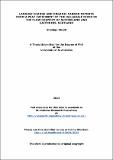Landuse change and organic carbon exports from a peat catchment of the Halladale River in the Flow Country of Sutherland and Caithness, Scotland
Abstract
Upland peat catchments are usually assumed to function as carbon sinks, however, there have been extensive studies witnessing increasing trends in concentrations and fluxes of organic carbon in UK rivers over the last few decades. A number of controls on dissolved organic carbon (DOC) release from peatlands, such as climatic changes and landuse management, have been
proposed. This study examines the effects of land use and management on
organic carbon exports in the Dyke catchment of the River Halladale (northern
Scotland) with a nested catchment approach. This study provides insight into
the processes controlling the DOC dynamics in the Dyke catchment, and the
impact of disturbance caused by landuse changes such as afforestation and tree
felling for restoration. The results from factor analysis, end-member mixing,
absorbance (E4/E6), and hysteresis analyses on stream water chemistry from
individual sub-catchments identified the major hydrological pathways during
storm events, and based on these results, conceptual models were developed to
explain DOC evolution during storm events. At all the sites studied, nearsurface
soil water was identified as the major controlling end-member for
stream DOC concentrations.
The calculated annual flux of DOC from the Dyke catchment, up-scaled
from the results of the individual sub-catchments, is 521.6 kg C ha⁻¹
yr⁻¹,
which is
significantly (~5 times) higher than the previously published value (103.4 kg C
ha⁻¹
yr⁻¹)
for the River Halladale catchment (Hope et al., 1997). In this study, it is
shown that about 57 - 95% of the DOC export occur during 5 - 10% of the high
flows, therefore, it is crucial that quantitative records of DOC export are
developed using high frequency storm event measurements, as well as lower
frequency low flow sampling.
Climatic changes related to precipitation, temperature, coupled with
water yield capacity of the sub-catchments, are identified as significant controls
on DOC fluxes, rather than landuse change, as the intact site releases more
organic carbon per unit area compared to the disturbed and re-wetted site
undergoing restoration. In addition, the results from this study provide
landowners, policy makers and organisations with the evidence they require for
initiating future peatland restoration works, as felling of forestry coupled with
drain-blocking is shown to be an effective restoration technique that may help a
catchment to eventually return to a near-pristine state.
Type
Thesis, PhD Doctor of Philosophy
Collections
Items in the St Andrews Research Repository are protected by copyright, with all rights reserved, unless otherwise indicated.

